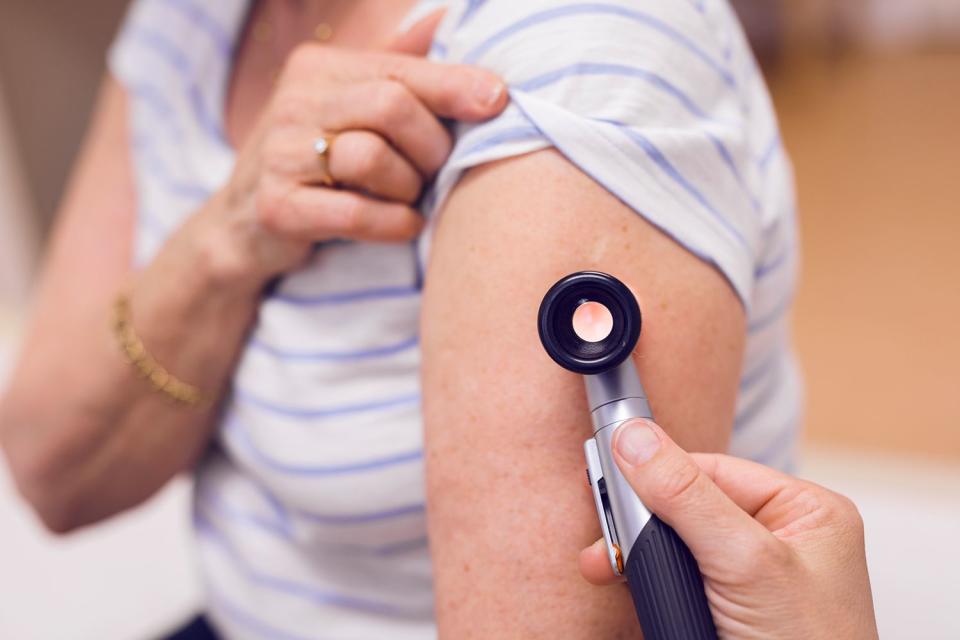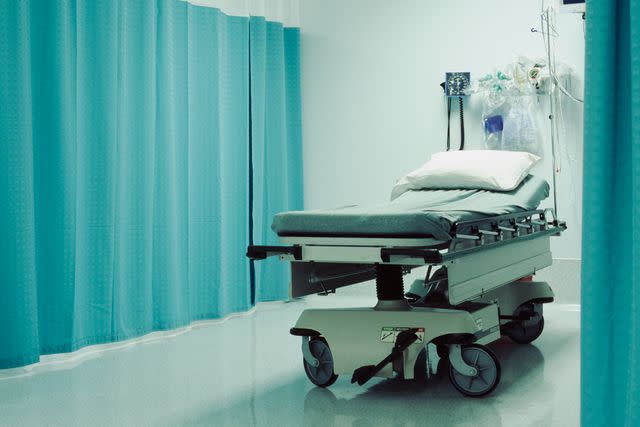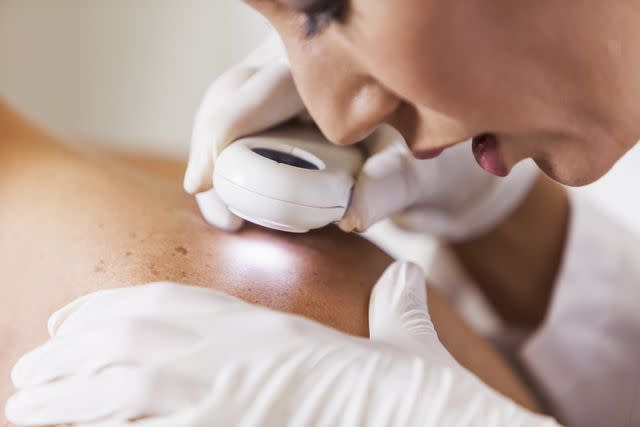Woman Survives Melanoma After Having 100 Abnormal Moles Removed
Two months after Theresa Kurtz's mother died of melanoma, she went to the dermatologist and was diagnosed with stage 0 melanoma

Getty
Stock image of doctor examining senior woman's skinOne woman was diagnosed with skin cancer two months after her mother died from melanoma.
It was confirmed that Theresa Kurtz had melanoma and three severely abnormal moles that were on the brink of becoming melanoma. The now 38-year-old woman was then treated by doctors who had to remove and biopsy 100 suspicious moles on her body.
Melanoma is the deadliest form of skin cancer that can grow quickly and spread to any organ if not found and treated early, per the Cleveland Clinic.
The American Cancer Society hypothesizes that throughout 2024, more than 100,000 new cases of melanoma will be diagnosed and over 8,000 patients will die from it. According to Affiliated Dermatologists, most adults have an average of 10 to 40 moles on their bodies, and those with 50 moles or more are at an increased risk of developing skin cancer.

Getty
Stock image of Gurney in hospital roomAt the time of her diagnosis, she was 28 and went to the dermatologist at her late mother’s request. “She had always wanted me to go get checked,” Kurtz told TODAY.com. “It took her death for me to take that seriously.”
“I was still grieving my mom and figuring out life without her, and then to hear the same thing — at first, there was a lot of anger. And then I just turned that anger into: How can I tell my story and help other people?”
Related: Beautician Alerts Client to Irregular Mole and Saves Her from Deadly Skin Cancer
She revealed to TODAY.com that she had a high risk of contracting melanoma due to her family history of skin cancer, as well as her fair skin, red hair, several moles on her body, and ultraviolet light exposure.
Kurtz explained that she’s spent a lot of time outside throughout her lifetime, and during her childhood, her parents always made her wear sunscreen. She admitted that once she hit adolescence, she wasn’t as strict with sunscreen application. “You think you’re invincible and nothing’s going to happen to you,” she said.
She also noted that she used tanning beds throughout high school. (The National Library of Medicine has documented that women under 30 were six times more likely to develop melanoma if they tanned indoors.)

kali9
Stock photo of Dermatologist examining patient for signs of skin cancerShe explained that her mother, Mary, was diagnosed after she felt so sick. Believing she had shingles, she went to the emergency room in the summer of 2014.
Kurtz shared that her mother’s scans and tests discovered melanoma in her liver, brain and bones. “It was everywhere,” Kurtz recalled, adding that the doctors informed her family Mary’s undetected melanoma may have metastasized after spreading to a lymph node.
Then in August 2014, her mother died at 54 within a month of getting a stage 4 melanoma diagnosis.
Two months later, Kurtz headed to the dermatologist. During that appointment, she had 28 suspicious moles removed and biopsied. Of the 28, one of them was a stage 0 melanoma, as it had not grown deeper than the top layer of her skin. However, the spot needed to be surgically removed and left a 9-inch scar underneath her right breast. Three more abnormal moles were also removed.
“I look back, and every day I’m so thankful that I did listen to her, finally,” she explained. “I love my scars. For me, it is 100% proof that I’m stronger than what tried to harm me,” adding, “I wear them so proudly.”
Related: Sarah Ferguson Reveals Skin Cancer Diagnosis Weeks After Announcing That She 'Beat' Breast Cancer

fstop123
Stock photo of woman at doctor's office or hospitalAlthough it's been 10 years since that melanoma was found, she shared that doctors have removed and biopsied 100 suspicious spots on her body. Those first five years Kurtz underwent skin checks, blood tests and X-rays every few months to ensure the melanoma hadn’t spread.
“I could sit and kind of wallow in the (self) pity of, ‘This is awful.’ But instead, I try to tell my story in hopes that someone else will hear what I heard from my mom and go get checked,” she explained to TODAY.com. “I do really hope that someone can hear this and go, ‘Hmm, I probably should go get checked or go to the dermatologist.’ ”
Never miss a story — sign up for PEOPLE's free daily newsletter to stay up-to-date on the best of what PEOPLE has to offer, from celebrity news to compelling human interest stories.
People are urged to monitor their skin, and doctors recommend paying attention to the warning signs of melanoma, including the ABCDEs: asymmetry, border, color, diameter, and evolving shape.
Additionally, people should always apply sunscreen with an SPF of 30 or higher, seek shade and wear sun-protective clothing.
For more People news, make sure to sign up for our newsletter!
Read the original article on People.


